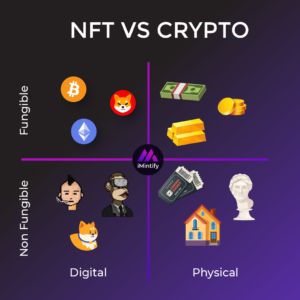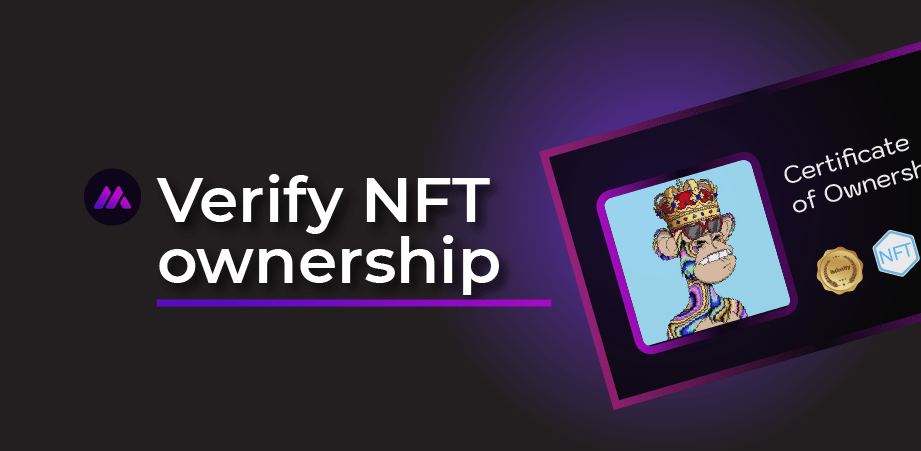|
Getting your Trinity Audio player ready... |
Technology drives innovation and the same goes with blockchain technology. Non-fungible tokens (NFTs) are one such amazing example, mostly residing on the Ethereum platform. They are a new revolution in itself. While some experts say they are just hype like the dot coms or beanie babies and are a bubble poised to pop, others believe that non-fungible tokens are here to stay and will completely change the dynamics of investing.
The frenzy is growing every day and looks like the NFT boom will be on for many more years to come.
Contents
What is NFT stand for Non-Fungible token?
NFT expands to Non-Fungible Token. Non-fungible means irreplaceable or that which cannot be interchanged. For instance, 1 BTC is equivalent to another 1 BTC,

however, no two NFTs are equivalent, though both are non-fungible tokens. A Van Gogh painting is unique and cannot be exchanged for a Monalisa painting.
Well, technically it is a cryptographic, digital asset stored on a blockchain such as Ethereum. It could be any digital objects like video, audio, images, collectibles, tweets, music, artwork, literally anything. As such, a digital file is fungible as you can make numerous copies of it. However, NFTs are unique and offer ownership rights to the creator or owner. Any digital file is not an NFT. These digital files undergo a process called minting by which certain unique attributes are embedded in them and stored on the blockchain. Only such files are non-fungible tokens and are unique.
How does NFT work?
They are digital assets stored on blockchains, particularly Ethereum. Other blockchains such as Solana and Binance are also coming up with their versions.
They are essentially tokens, or a utility that allows users to designate their artwork or collectibles and offer uniqueness and ownership title. They are created or minted and stored on the blockchain, making it possible to associate an owner with them. They are cryptographic, digitally protected objects. The digital objects’ information is strung as blocks of data that forms a chain and is decentrally residing on a peer-to-peer network.
Digital representations could be in the form of art, images, video, audio, tweets, collectibles, etc. They are like physical items, however, in a digital form. They are minted through a feature called smart contracts. These are pre-defined agreements that execute automatically when certain conditions are met. Certain NFT smart contracts contain a royalty clause that ensures that each time someone buys the NFT, the original creator receives some amount as royalty.
What are NFTs used for?
They have a wide range of applications. With them, artists and creators don’t have to rely on art galleries and auction houses to sell their art. They directly connect the artists to the audiences to whom the digital assets are sold. Even if you can’t own a Monalisa oil painting to hang on the wall, you can be the owner of an equally precious digital file instead. Besides, they help creators generate a passive income by monetizing their artwork.
Modern finance comprises sophisticated trading and loan systems supporting various asset types ranging from real-estate trading to lending artwork. By having digital representations of physical assets, Non-fungible tokens are a step ahead in the reinvention of this infrastructure.
They are an excellent means of serving the purpose of identity management. Consider the case of physical passports that need to be produced at various entry and exit points. By converting them into non-fungible tokens with unique identifying attributes, it is possible to streamline the entry and exit procedures. This use case can be extended to work in the digital realm as well.
They also democratize investing by fractionalizing real-world physical assets. It is much easier to divide a digital land among multiple owners than a physical real-estate asset. The tokenizing ethics need not be only constrained to real estate but extended to painting or artwork as well. The painting need not always have a single owner. Different people could own different portions of its digital equivalent. Such kinds of arrangements enhance the worth and increase revenue.
The most useful feature entails the creation of new markets and forms of investment. Consider a piece of land parceled out into multiple divisions, each with different characteristics and property types. For example, one piece might be beach-facing, another could be suitable for a shopping complex, and yet another for a residential building. With non-fungible tokens, these can be categorized easily and priced differently based on their attributes. Real-estate trading, a highly complex affair could be simplified by incorporating relevant metadata into their tokens.
These are just a few examples of the innovative applications that NFTs offer, however, the list is endless.
How is NFT different from cryptocurrency?

Though cryptocurrency and NFTs both work on blockchains, there are some core differences. Cryptos are fungible while NFTs aren’t, as their name suggests. Besides, cryptocurrencies such as Bitcoin and ETH are used only in financial transactions and payments on the blockchain network. Non-fungible tokens, on the other hand, are digital files such as audio, video, images, or tweets stored on the blockchain that are unique and offer ownership titles to their owners and creators.
They have a built-in authentication that serves as proof of ownership. They can have only one owner at a time. Besides, the owners and creators can add specific information such as their signature to the digital artwork, by including it in the NFT’s metadata.
Thus, they provide a novel way to showcase art or collectibles, enabling art lovers to enhance their memorabilia. There is however a close link between non-fungible tokens and cryptocurrency. As both operate on the blockchain platform, the buying and selling of NFTs take place through cryptocurrencies. In other words, cryptocurrency is the sole medium to trade NFTs.
How to buy NFTs?
If you wish to build a collection of your NFTs, you must acquire certain key elements as prerequisites.
Most of them are built on the Ethereum blockchain, though there are others on Binance and Solana. In any case, you need a crypto wallet to store your cryptocurrency. You can open wallets by going to the sites of your preferred platforms such as Coindesk, Metamask, etc., and register to open a wallet. After opening the wallet, you need to transfer cryptos into the wallet to be able to purchase the art.
You can buy cryptocurrency from exchanges such as Coinbase, Kraken, or eToro using credit cards. Then, you must transfer the cryptocurrency from the exchange to the digital wallet of your choice. Or you can buy / mint them from a minting website.
Now that you have your digital wallet and the required amount of cryptos, you can shop on any NFT marketplaces such as Opensea, Rarible, etc., and visit the collections to spot the item of your choice. You just need to sign up to get started.
Once you have an account on the marketplace, you will find that usually there are 3 options to buy. You can buy it at a fixed price or at an unlimited auction. Or, the third option is a timed auction wherein the bidding is available only for a certain duration. Marketplaces offer various search bars, filters, top-performing stats, and more to make your buying experience enjoyable.
Popular NFT Marketplaces
If you want to shop for NFTs, you have a plethora of choices available. There are hundreds of NFT marketplaces where you can buy and sell them. Some of the popular marketplaces are discussed here.

Opensea: Opensea is the largest and most famous NFT marketplace. It offers NFT lovers and enthusiasts thousands of extensive offerings. Besides, the easy-to-use
interface allows users to navigate conveniently on the platform and select from the best offers.
It supports more than 150 payment tokens and thus is a great place to start with. You can also create your own NFTs by minting them.
Rarible: Rarible is also as large and popular as the Opensea marketplace. It offers an awesome collection of NFTs including images, video, audio, music, art, and almost everything. The only difference from Opensea is that Rarible allows users to pay using its native token Rarible (RARI).
Axie Marketplace: This marketplace is an online shopping portal for the video game Axie Infinity. Axies are imaginary creatures that can be bought and sold as NFTs and can be made to challenge each other as a part of the Axie game. On this marketplace, players can buy Axies, land, and other in-game assets and earn rewards as they play.
They are built on the Ethereum blockchain and can be bought on other platforms as well.
Larva Labs: Larva Labs are particularly well-known for their CryptoPunks collections. Some CryptoPunks have sold for millions of dollars since 2017. Besides, these Labs have other famous collections such as Autoglyphs and other Ethereum-based app development projects as well.
The CryptoPunks collections are sold out, however, they can be bought from third-party marketplaces.
Should you buy NFTs?
Just because you can buy NFTs does not necessarily mean you should. It depends on various factors. Since they are new, their future is a bit uncertain and also there’s no information to judge the history of their performance.
It is recommended to buy NFTs by starting small, meaning investing in small amounts. If you have something, an artwork or collectible that holds value and also the money to shell out, then it’s worth considering.
However, you must keep certain pointers in mind. An NFT’s value depends on what someone else is willing to pay for it. This means their price is driven by demand and not by fundamental or economic indicators as generally happens in the case of stock prices or cryptocurrency. It is possible that you sell your non-fungible token at a lower price than what you paid for it. Also, it may not resell as no one is interested to buy it!
With these uncertainties in mind, you must invest carefully in NFTs.
Closing thoughts
Non-fungible tokens are all the rage and this goes beyond merely showcasing artwork or collectibles. They have a lot more useful applications that can transform the way we live. With the evolution of Web 3.0 imminent, making the emergence of the Metaverse inevitable, the NFTs have a very significant and crucial role ahead.



